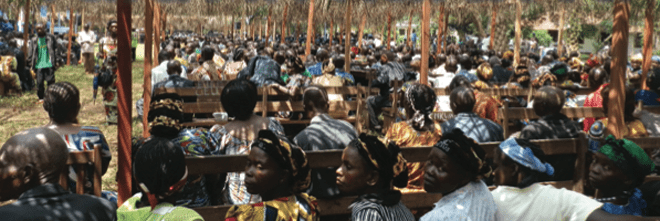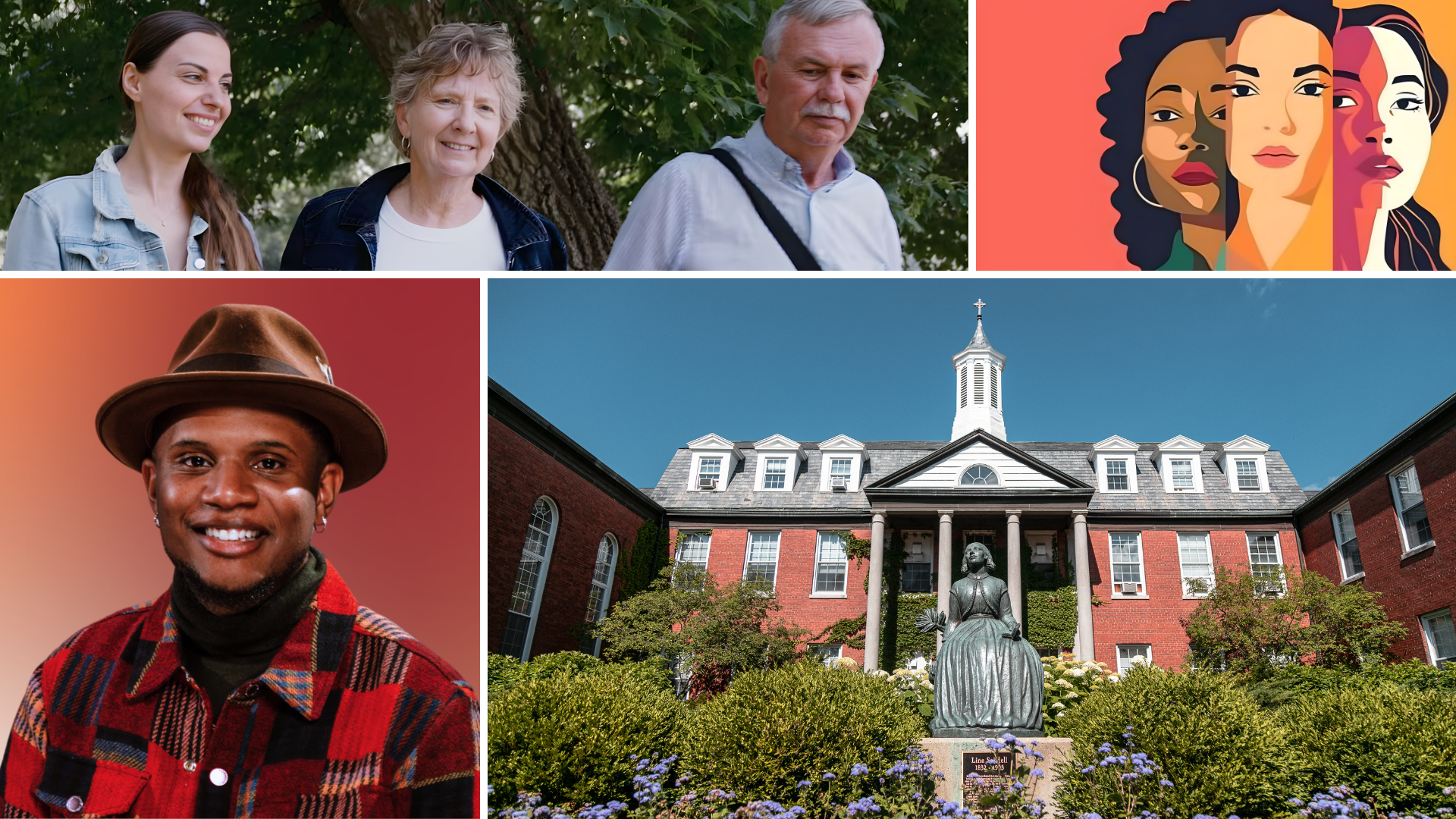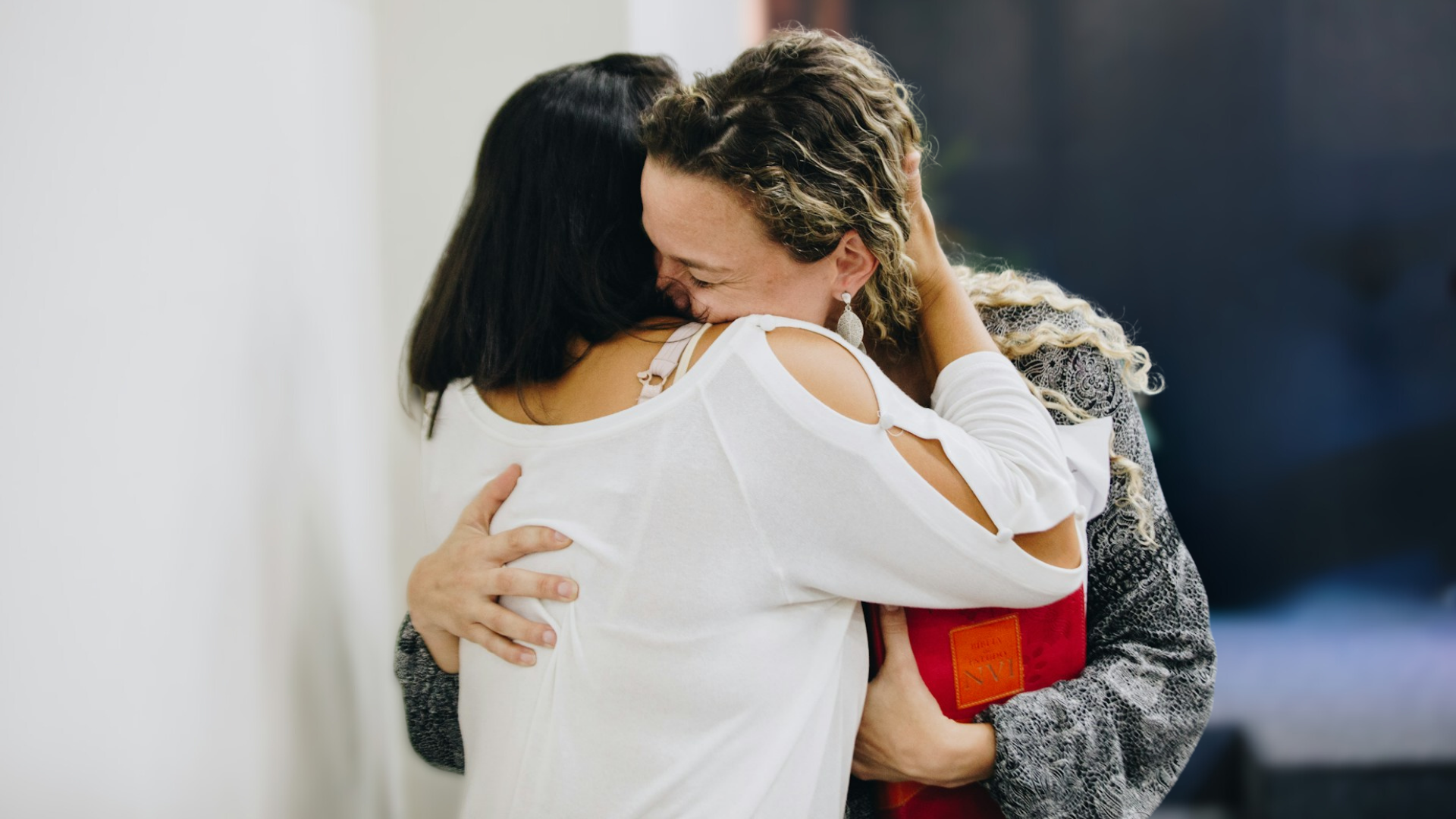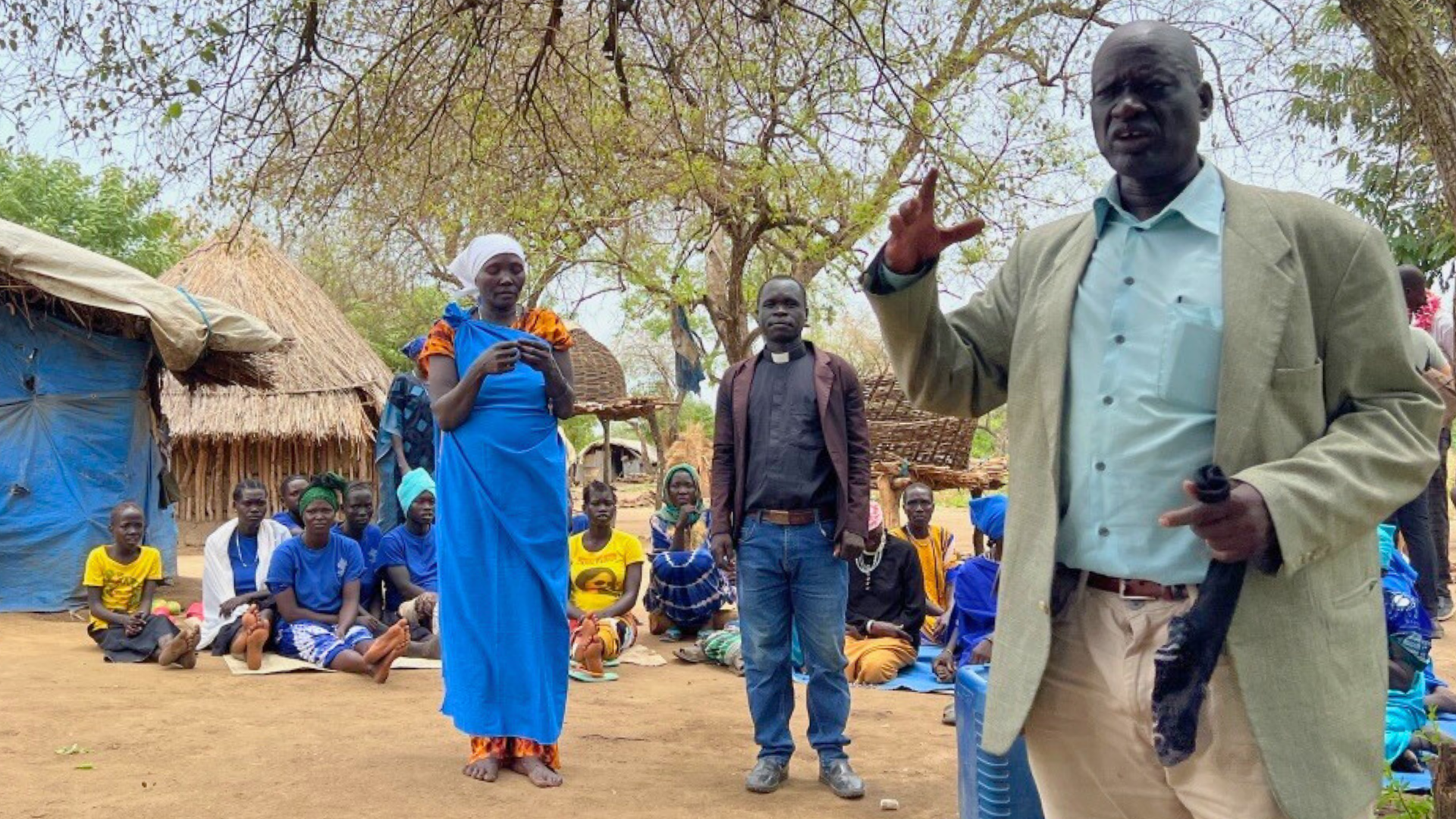In the wake of DR Congo’s devastating civil war, one hospital’s continued witness gives hope for the future.
The child died twenty feet from us. Marta Klein, a short-term missionary and physician assistant working with the Department of World Mission and Paul Carlson Partnership, was giving another missionary and me a tour of the Karawa Hospital in the Democratic Republic of Congo. The first stop was the pediatrics wing. Although we had walked right past the boy when we entered, we hadn’t seen him because he was surrounded by family members and a nurse just inside the door.
Several hundred yards away a speaker was addressing thousands of people who had gathered in a field nicknamed Times Square to celebrate the seventy-fifth anniversary of Covenant ministry in DR Congo. During the worship, a band let loose music that sounded like an amal- gam of Cajun and Cuban with some West Indian sounds thrown in. A team of young girls in white dresses and white socks danced on the grass. It was a jubilant morning on an unseasonably pleasant day in August, with the sun’s heat tempered by a partly overcast sky.
We entered a different world, however, when we stepped into the pediatrics unit. Despite the windows, the room felt like an underground cinder-block parking garage. Sixteen rusted iron beds were lined up in two rows along the walls. Staff kept the cracked concrete floor as clean as possible, but dirt settled into the crevices. Vertical windows spaced along the length of the building swung open to allow in the breeze. Yet no matter how much light filtered through, it didn’t obliterate the dreariness.

Many of the children lay or were propped up in their beds. Some parents and siblings played with the patients. Other families sat quietly, somewhere between stoic and resigned. In the first bed just to the right of the main door, a father kept an expressionless vigil over his small, gaunt son who was no more than four years old. The boy suffered from malnutri- tion and malaria, the two most frequent killers of children in the Congo. (Malaria kills more than 300,000 children a year, and malnutrition leads to stunted growth for 43 percent of children under the age of five.)
Parents and other family members sat outside in an area set up so they could cook over a small fire for themselves and the patients. The two dollars a day it costs to stay in the hospital pays for the bed, nursing care, and simple diagnostic tests. It does not cover meals. Families bring food with them or they have to go find it. They do this every day, and the average stay in the hospital is five to seven days.
To combat the pervasive malnutri- tion, Klein has started a program that involves grinding up the leaves of the Moringa tree into a powder that is mixed with other food. Moringa leaves are a fast-growing “super food” packed with nutrients. Since starting the program, she has provided the powder to 500 people, with a pri- mary focus on children and pregnant women. The results have been good so far and have led to critical weight gains. She tries to chart the progress of the recipients, but return visits are sporadic. Some patients must walk as many as six miles each way, and the journey costs them time spent in their gardens, which provide much of their sustenance.
Klein was describing the program to us when the mother of the child near the front door screamed in Lingala, “No! Why, why?” She stumbled into the main room bent over with both arms clutching her stomach. The mother wailed as she made her way down the aisle between the beds, stopping every several feet, all the while pleading, “Why?” to no one and to God.
She collapsed by a bed near a door opened to the outside, continuing to scream, “Why? Why? What have I done to deserve this?” The children and their parents watched her silently from their beds. A nurse tried to coax the wailing woman to stand up and then ultimately pulled her to her feet and took her out- side, where other staff and family could better attend to her.
 A few minutes later a nurse handed the boy’s body to one of the mother’s relatives, who would carry the child for the nearly three-mile walk home. That night or the next morning they would bury him. Ask a parent here how many children they have, and they likely will respond along these lines: “I have five. Three are living.”
A few minutes later a nurse handed the boy’s body to one of the mother’s relatives, who would carry the child for the nearly three-mile walk home. That night or the next morning they would bury him. Ask a parent here how many children they have, and they likely will respond along these lines: “I have five. Three are living.”
Mireille Bembide, a nurse in the pediatrics unit at the hospital, sat in the nurses station and spoke a hesitant almost apologetic lament. “It is very sad when we don’t have enough materials to do our work. It is so hard when we see children who are sick and we can’t help them. We keep giv- ing them medicine until they die in our hands.”
“Grief is a common experience here,” Klein said, trying unsuccessfully to fight back tears after the mother left the ward. “The boy died of malnutri- tion. This doesn’t have to happen. It doesn’t have to be this way.”
Karawa Hospital consists of several decades-old build- ings separated by manicured hedges. They hold X-ray and physio- therapy, internal medicine, operating rooms, maternity, ophthalmology, dentistry, depots for the hospital’s and the Congo Covenant Church (CEUM) pharmacies, an outpatient clinic, and a laboratory for HIV, leprosy, and tuberculosis.
For many years now, electricity has been available only several hours a week, if that, and there is no conti- nous clean running water. Medicines are hard to come by and expensive. The ceilings in some rooms have large holes. It is an understatement to say the hospital is ill-equipped.
 On the day we were there, a nurse had just finished giving an HIV test using rudimentary equip- ment stored on a table permanently stained blue and purple by chemicals. The government supplies the kits, but there are not enough, said one nurse. Nurses might not be paid for months. Most doctors have left for other jobs because there is little money at Karawa or anywhere among the CEUM health system, which includes five hospitals and ninety-five health centers.
On the day we were there, a nurse had just finished giving an HIV test using rudimentary equip- ment stored on a table permanently stained blue and purple by chemicals. The government supplies the kits, but there are not enough, said one nurse. Nurses might not be paid for months. Most doctors have left for other jobs because there is little money at Karawa or anywhere among the CEUM health system, which includes five hospitals and ninety-five health centers.
The challenges at the hospital are hardly unique in this country one – quarter the size of the United States and inhabited by seventy-one million people. Foreign Policy magazine ranks DR Congo as the second worst failed state in the world, behind only Ethiopia; the World Bank lists it 178 out of 183 countries in which to do business; and the United Nations identifies it as the poorest nation on the planet. Equateur Province in the far northwest region, where the CEUM ministers, is the poorest area of this poorest country.
DR Congo also has been one of the bloodiest places in the world, plundered by outsiders for its natu- ral resources since colonial powers divvied up Africa in 1885 and gave Belgium’s King Leopold II personal control of the newly drawn “Congo Free State.” He subsequently commit- ted what scholars say is among the worst acts of genocide in history as he exploited the country for its rubber latex, minerals, and ivory.
Since the Congo gained its independence in 1960, its rulers have kept the country on its back, observers say. Leaders have gained or held onto power through violence, including the murder of their predeces- sors. Rampant corruption, ethnic strife, rigged elec- tions, lack of educational opportunities, harassment of foreigners by military
and ill-trained police, poor health care, as well as shortsighted government policies that scare away foreign invest- ment, all contribute to the country’s destitution.
The country suffers almost a complete absence of infrastructure. Making the roughly forty-mile trip on National Highway 24 between Gemena and Karawa can take several hours, depending on the condition of the red clay roadway. During our trip in August, a vehicle in which I was traveling between the two cities was trapped in the remnants of a washed- out bridge. (Funds from Paul Carlson Partnership paid for the bridge to be repaired in September.)
Hundreds of women, men, and children walk alongside the road for mile after mile to market, to their gardens, or to home – travel that might take up to two days each way. Women and young girls walk balancing large containers of goods on their heads. Some are dressed in their Sunday best, eyes fixed straight ahead. The fortunate men ride bicycles, carting sacks of grain weighing as much as two hun- dred pounds draped over the back or transporting pigs in carriers propped behind the rider. Men often have to push their laden bicycles up hills and through sections of the road that have all but fallen apart. Still, having a bike is a luxury.
The Congo’s neighbors, especially Rwanda and Uganda, also have wreaked havoc in the country. They make frequent incursions into the country with their own troops and provide support to rebels or the government. Alliances shift often. The most recent warfare has occurred in the east, where the country is esti- mated to have the equivalent of $24 trillion of untapped deposits of raw mineral ores, some of which are rare but needed for electronics such as computers and cell phones.
 Since 1960, violence has forced the Covenant to evacuate missionaries four separate times. The first was after the country obtained its independence from Belgium, leaving a power vacuum in the absence of indigenous leadership. The army mutinied, the mineral-rich province in the east attempted to secede, the prime minister died under suspicious circumstances, and the president was installed through military power.
Since 1960, violence has forced the Covenant to evacuate missionaries four separate times. The first was after the country obtained its independence from Belgium, leaving a power vacuum in the absence of indigenous leadership. The army mutinied, the mineral-rich province in the east attempted to secede, the prime minister died under suspicious circumstances, and the president was installed through military power.
A rebellion in 1964–1965 forced the second evacuation. It was during this conflict that medical missionary Paul Carlson, who had stayed behind to treat patients at the CEUM clinic in the northern city of Wasolo, was kidnapped and then murdered during a rescue attempt.
Covenant missionaries departed again in 1991 when soldiers in the capital Kinshasa mutinied over lack of pay and delayed reforms. As troops looted, French and Belgian forces flew to the city and evacuated 20,000 foreigners.
The fourth evacuation of missionaries occurred in 1997 shortly before the late president Mobutu was toppled by the move- ment of Laurent Kabila. That fighting turned into a full-fledged civil war that has been referred to as the African World War because at least half a dozen surrounding nations and roughly twenty unaffiliated armed groups engaged in the conflict, which proved to be the deadliest since World War II. By the time a peace accord was signed in 2003, more than five million people had died from the fighting, starvation, and disease.
From the beginning the Covenant’s work in DR Congo included both evangelism and medical outreach. Among the first four Covenant missionaries there were a physician and two nurses – Wallace and Sarah Thornbloom and Florence Nelson. They settled in Karawa and began the work that would eventually become the hospital. As new medical missionaries joined them and as they trained Congolese to become nurses, a network of clinics serving the Equateur Province was established.
Karawa Hospital was the only one for hundreds of miles and was consid- ered among the finest in the country. Medical trainees sought to do their residencies there, says Roger Thorpe, retired missionary surgeon who oversaw numerous students.
The hospital had running water, refrigeration to store vaccines, and by the mid-eighties, a continuous supply of electricity, thanks to the completion of the Zulu hydroelectric dam, designed by missionary Bob Thornbloom, Wallace and Sarah’s son. Prior to that, electricity was supplied by a fuel-powered plant, and was limited to two hours in the evenings and occa- sionally during the mornings.
Then the war struck. Civilians fled their homes to live in the jungles. When the soldiers finally left, Bofio Fumbele, a nurse in the hospital’s internal medicine unit, returned. He was devastated by what he saw. “It was horrible,” he said. “The soldiers came and took everything. Before the war there were enough medicines. There were mattresses and sheets. Patients had hospital gowns. Now we are missing all of that.”
Yet even as the Congo has suffered, the Congolese seem determined to hope. A writer for the BBC observed last year that they are “strong, vibrant, dynamic, tolerant and generous. People have a sense of taking charge of their own destinies.”
“They are making bricks without straws,” says Curt Peterson, executive minister of the Department of World Mission. “I’ve never seen a place where the people have the resourcefulness and resilience that I’ve seen there. There are no parallels.”
Conditions at the hospital have begun to improve. Less than half an hour after the child died, Gaspy Zongalinga, an electrician, accompanied us to other wards. He flipped on light switches in room after room. It was a gesture I do back home without think- ing, but until several weeks ago none of these rooms even had lights.
When soldiers looted the hospital during the war, they took all the wiring. Now, years later, Zongalinga is rewiring the facility. There are now working lights in the main room of pediatrics, maternity, and med and isolation rooms. “Even a little light makes such a big difference,” Klein says. That lighting includes a new overhead surgical lamp, so medical staff no longer have to hold up flashlights in the operating room. The new equipment includes heat lamps for keeping babies warm and a refrigerator to keep vac- cines cold.
New solar panels that Zongalinga installed have made this possible. Much of the equipment was paid for by special offerings to the Paul Carlson Partnership. The ministry’s executive director, Byron Miller, says the panels are a stopgap measure until new cables can be laid from the dam to the hospital.
The cost for that project is daunting and could reach as high as $600,000. Miller hopes a nonprofit organization comprised of religious groups in Ger- many will help defray the expenses. The nonprofit already has restored one of the generators at the dam, mak-
ing it operational for the first time in years. Funding from the Paul Carlson Partnership also has enabled a water wheel outside the community to be repaired and to provide flowing water to the hospital for a several hours a day. Solar panels are planned, which will power a pump at another spring to provide water twenty-four hours a day.
New international, regional, and local partnerships, as well as ongoing changes in current relationships, will bring new opportu- nities for the Congolese, say Covenant and CEUM leaders. Congo Covenant Church president Jules Mboka Ngate, who was elected earlier this year, said during his opening remarks at the anniversary celebration that the history of the denomination could be divided into two eras: missionary and post-missionary.
“Most of the missionaries suffered for the great work, and for that we are grateful,” he said. They were the ones who birthed and established the church, started local congregations, and developed health and education ministries that would indirectly impact the entire country. Because of that work, he said, “the CEUM has come of age.”
That maturity means the Covenant Church and CEUM are now working as partners – the new operative word for ministry here. What once needed to be done for the Congolese is now being done together, leaders say.
Covenant Kids Congo powered by World Vision is by far the biggest partnership. Through the project, Covenanters in North America spon- sor a child in the city of Gemena, with whom they can write or visit. Unlike other sponsorship programs, however, the entire community in Gemena will benefit as funds are used to provide access to clean water and health care as well as build schools and offer micro-enterprise loans. It is a partnership among World Vision, World Vision Congo, the CEUM, and the Covenant Church. World Vision has never attempted a project on this scale with any denomination, and Covenant Kids dwarfs the scope of any of the denomination’s previous work.
Gemena is a city of some 118,000 people, nearly all of whom live in small red brick huts with tin or grass-thatched roofs. The homes are situated on the red clay in cleared sections of the forest and tall grasses. Some areas have a single house, while others may have three or four, likely all belonging to one family. Few people have access to electricity for refrigerators, and there are no grocery stores so food must be purchased at open markets each day.
Covenant Kids Congo has chosen several neighborhoods, starting with the poorest, in which to begin the work. They have named the project Ledia, which is Mbaka for “new community.” A delegation of Covenant- ers from the United States met with families in Gemena in August after the celebration in Karawa. The mother of one sponsored child, Charlie (pronounced SHARlay), sat outside their home while Charlie and her younger brother played. She told a too-common story of walking to get water every day from a spring. The walk is not far, but the women must wait their turn, sometimes as long as four hours. The children love school, but the facilities are woefully inadequate. Health care is both meager and too expensive.
The family is participating in the project with wary hope. Charlie’s mother stated that more than one organization has come to her community, making promises that were never fulfilled. She and others are encouraged, however, that they will participate in decisions on how the projects proceed and that all the children will benefit.
 World Vision has operated a similar area development project on a smaller scale with a single Catholic church in Kikimi, an area outside Kinshasa. At least 75 percent of the people making decisions on the project are local residents. The community has experienced a substantial change in just a few years. During a visit with Covenant project leaders, women described how a microfinance initiative and their collective labor enabled them to earn enough money to pay for all of their children to go to school and purchase the requisite uniforms. A young boy described how hard it had been to read and write while sitting on a dirt floor and using his knees as a desk to hold his paper. He now attends a new school furnished with desks made by men who live in the village. He dreams of becoming a headmaster of that school. Clean water is flowing into the neighborhood.
World Vision has operated a similar area development project on a smaller scale with a single Catholic church in Kikimi, an area outside Kinshasa. At least 75 percent of the people making decisions on the project are local residents. The community has experienced a substantial change in just a few years. During a visit with Covenant project leaders, women described how a microfinance initiative and their collective labor enabled them to earn enough money to pay for all of their children to go to school and purchase the requisite uniforms. A young boy described how hard it had been to read and write while sitting on a dirt floor and using his knees as a desk to hold his paper. He now attends a new school furnished with desks made by men who live in the village. He dreams of becoming a headmaster of that school. Clean water is flowing into the neighborhood.
Several international organizations are looking at the Covenant’s joint venture and have expressed an interest in providing grants and other funding sources for complementary projects in Gemena. One recently promised a new and much larger source of medicines, which will be used in Karawa and some of the clinics.
The Covenant is committed to the bold new ministry as well as continu- ing ongoing work because of the denomination’s long history and the desire to be faithful to God’s call to serve the poorest of the poor, Covenant president Gary Walter told the gathering in Karawa.
More than 1,000 pastors who serve the CEUM’s 238,000 members attended the anniversary celebration. Many had traveled for days on foot or bicycle. They and other Congolese worshiped for hours on end, including the closing eight-hour service.
“The joy and faith and exuberance in worship is not tempered by their extreme conditions,” says Curt Peterson. “Their attentiveness for hours, the shared participation in song and dance and prayer, the evidence of their outreach that their faith has to be shared with others. None of that is muffled by the agony of their daily life. They trust that God is with them in this suffering and hardship.”
Nurses in Karawa arrive around 6 a.m. and then attend chapel at 7 a.m. Bofio Fumbele looks forward to the service and prays throughout the day. “Prayer encourages my heart,” he explained. Sitting at his desk in the internal medicine unit, Fumbele was eager to show us his Bible. He lifted up the well-worn book that is sev- eral inches thick with pages stained a bluish-purple at their edges. “This is my armor,” he declared. “It helps me.”














